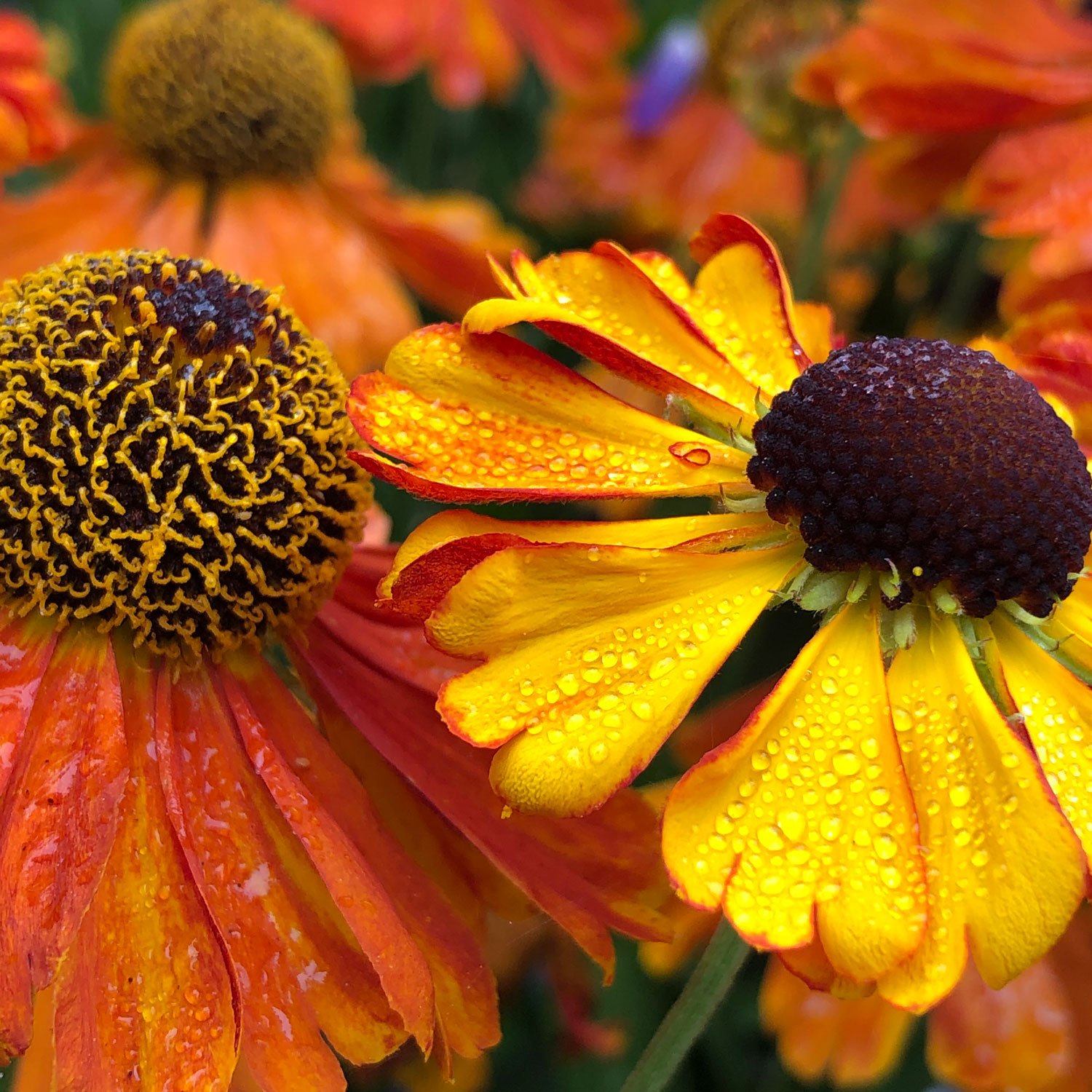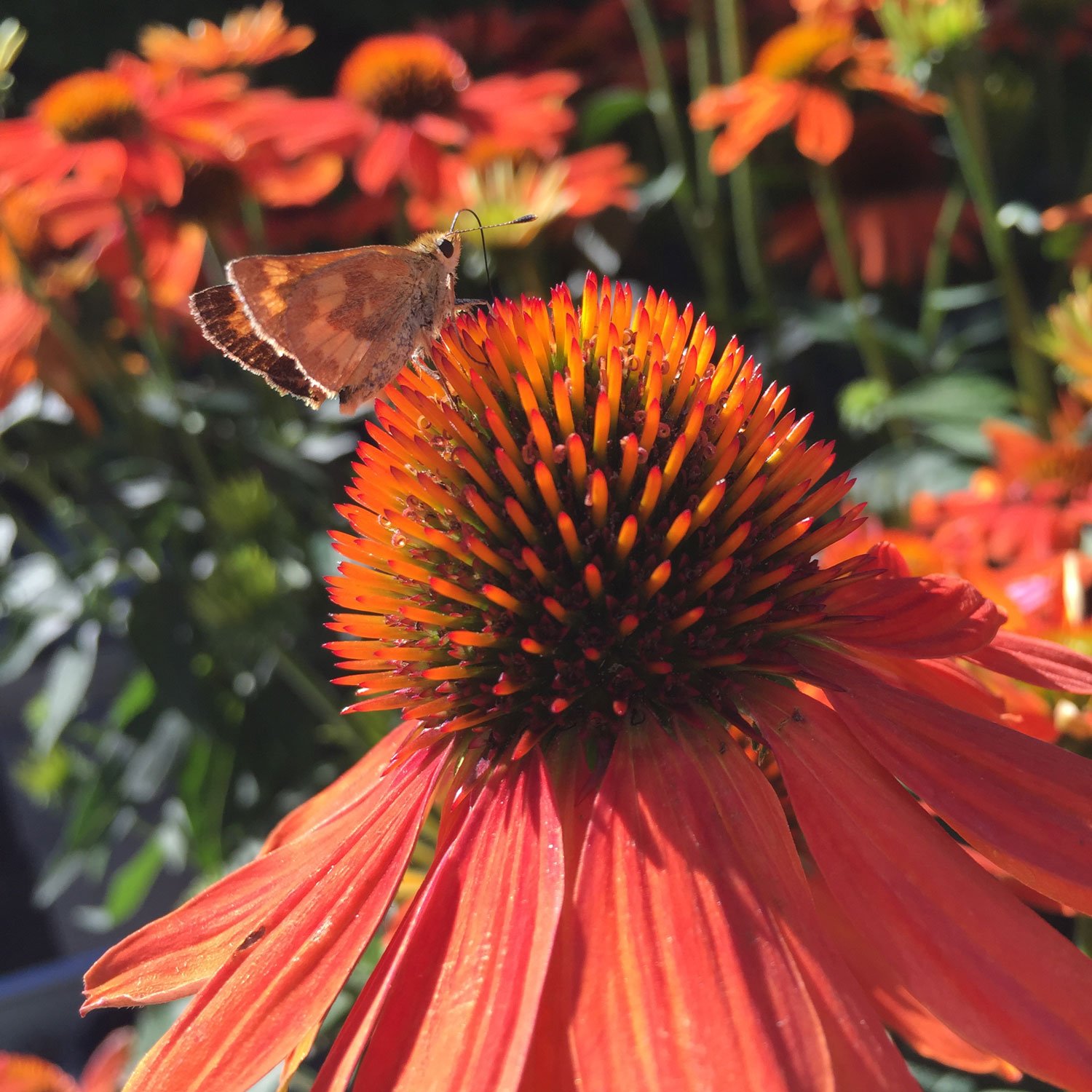Our gardens can be precious spaces of quiet, calm, and peace (our neighbor’s zeal for power tools notwithstanding) but they are also places of intense and important activity for the bees, butterflies, birds, and myriad of other insects that rely on gardens for sustenance and shelter.
Stand in the garden and listen to the buzz and whir and whoosh of creatures feeding and resting and socializing. All that activity also provides the essential service of pollination! Pollinators come in all shapes and sizes: bees, moths, butterflies, beetles, flies, and even bats, just to name a few. Knowing which plants serve our pollinators the best and incorporating them into our gardens helps to create a healthy and vibrant ecosystem where flora and fauna thrive.
Here are a few of the many plants with flowers that attract pollinators to your garden. In this post, we’ve focused on perennial flowers for bees, butterflies, and hummingbirds. Because these plants are perennials, they will return year after year, offering a feast for our pollinator friends and beauty for us to enjoy.
Helenium
Attracts: bees, butterflies
Full sun to part shade
Blooms summer through fall
The bright gold, orange, or red petals and unique dark centers of Helenium make it a standout in the garden. The flowers of this perennial also make an excellent landing pad for bees and butterflies looking for sweet nectar. Grows to 1’-3’ tall x 15"-18" wide, depending on the variety.
Achillea (Yarrow)
Attracts: bees, butterflies
Full sun
Blooms mid-spring through fall
What’s not to like about Yarrow. This flowering perennial is drought tolerant once established, thrives in hot, dry spots, and attracts a bevy of pollinators to the garden with its long-lasting blooms in an array of colors. Grows to 2’-3’ tall and wide.
Agastache (Hyssop)
Attracts: bees, hummingbirds
Full sun to part shade
Blooms summer through fall
Agastache is a dependable summer bloomer, with aromatic spikes of flowers in a variety of colors and shapes that bees and hummingbirds absolutely adore. This perennial hates wet feet and prefers well-draining soil. Drought tolerant once established. Grows to 20"-36" tall and 16"-32" wide, depending on the variety.
Aster
Attracts: bees, butterflies
Full sun
Blooms mid-summer through fall
Perennial Asters are one of the best flowers for late summer and fall color in the garden, blooming in vibrant shades of pink, purple, blue, and white. Pollinators appreciate having a feast of Aster nectar in the fall when many other flowers are dying down! Grows to 1’-6’ tall and 1’-4’ wide, depending on the variety.
Coreopsis
Attracts: bees, butterflies
Full sun to part shade
Blooms summer through fall
Sweet, sunny Coreopsis are easy-to-grow members of the Sunflower family whose blooms attract bees and butterflies, and whose seed heads attract birds. Several varieties are available in bright, warm tones of yellow, orange, and red. This perennial grows 18"-24" tall and wide, depending on the variety.
Rudbeckia (Black-Eyed Susan)
Attracts: bees, butterflies
Full sun
Blooms mid-summer through fall
Did you know that Rudbeckia is considered one of the top 10 perennials of all time? It's a reliable and long-lived plant, with masses of deep yellow flowers that attract bees, butterflies, and other beneficial insects. It also makes a great cutting flower for bouquets. Grows to 24"-36" tall and 18"-24" wide, depending on the variety.
Penstemon
Attracts: bees, butterflies, hummingbirds
Full sun to part shade
Blooms mid-spring to early summer
Did you know there are over 50 Penstemon species native to the PNW? The lovely flowers are irresistible to hummingbirds, bees, butterflies, beetles, moths, and more. This perennial thrives in well-drained soil and grows 6”-6’ tall and 1’-2’ wide, depending on the variety.
Echinacea (Coneflower)
Attracts: Bees, Butterflies
Full Sun to part shade
Blooms mid-summer through fall
Echinacea (also called Coneflower) is a staple of summer, attracting beneficial insects of all kinds and bringing cheerful color to the garden. Cut flowers can last 10 days or more in bouquets. Grows to 24"-36" tall and 24" wide, depending on the variety.
Monarda (Bee Balm)
Attracts: bees, butterflies, hummingbirds
Full sun to part shade
Blooms mid-summer through early fall
The unique tubular flower heads and whirls of bracts below make Monarda a standout amongst garden perennials. This pollinator-attractor creates a dramatic impact when planted en masse and the tall, sturdy stems even provide winter interest in the garden. Grows to 1’-4’ tall and 1’-3’ wide, depending on the variety.
Abelia
Attracts: bees, butterflies
Full sun to part shade
Blooms summer through late fall
Abelia is one of our favorite compact shrubs with arching stems and delicate flowers in white and pink tones. These deciduous shrubs are a favorite of bees and continue to bloom after many summer flowers have disappeared. Some varieties have colorful variegated foliage as well. Grows to 1’-8’ tall and wide, depending on the variety.
Hardy Fuchsia
Attracts: hummingbirds
Sun to shade
Blooms late spring through fall
Hardy Fuchsia is a hummingbird magnet with pendulous, tubular flowers on gracefully arching branches. This perennial prefers part shade but can grow in conditions ranging from full sun to shade as long as they are not near a hot west- or south-facing wall. Grows up to 1’-6’ tall and 1’-5’ wide, depending on the variety.
Integrating pollinator-friendly plants into your garden not only helps these essential creatures but adds beauty and color to the landscape throughout the year. Remember to add sources of water and shelter to make your garden habitable for your pollinator friends.
Visit our Attracting Pollinators & Wildlife Guide to see more blog posts, plant care guides, and other pollinator resources.
You can also find more information about pollinators from these resources:
Pollinators.org: Selecting Plants for Pollinators
Hummingbirdsociety.org: Flowers for Hummingbirds
Dunn DIY & Swansons Nursery: Plants that Attract Pollinators in the PNW
Swansons Nursery: Pollinator-Friendly Plant List
Editor’s Note: last updated in July 2022























